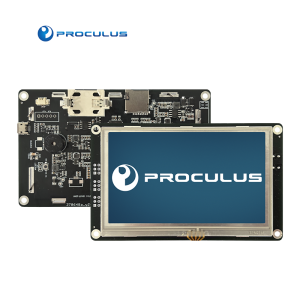What is the Difference Between Commonly Used LCD Module Displays and Industrial LCD Displays?
1. The difference between the color reproduction degree of the TV LCD module and the industrial LCD module
Due to the requirements of the use environment, the image of the LCD module of the TV is displayed after polishing, which cannot fully reflect the actual effect. Because what the display screen observes is usually a static image, the requirements for the color reproduction degree of the display screen are higher than that of the TV. The video playback channel of a professional display screen should have a precise compensation circuit and delay circuit in luminance, chrominance processing, and R, G, B processing to ensure the phase synchronization of bright/color signal and R, G, B signal. If the definition is depended by the amplitude-frequency characteristics of the video channel, the restoration degree lies on by the phase of the chrominance signal and the luminance signal of the three primary colors of red (R), green (G), and blue (B) in the display screen.
The LCD TV screen has no BNC self-locking color difference input interface and DVI-D interface. Ports are used in industrial LCD screens, such as RGB and BNC chromatic aberration interfaces with self-locking mechanisms and professional DVI-D video interfaces.
2. The industrial LCD module should be dust-proof and heat-proof
For LCD TV displays, there are no strict requirements for dust and heat resistance. When designing industrial LCDs, it is imperative to use no mechanical exhaust fans to maintain air circulation and heat dissipation, thereby avoiding dust and fan noise issues. When the internal temperature rises for unknown reasons, the display automatically controls the backlight system to keep the temperature below the maximum operating temperature.
In terms of process requirements for installation, and debugging, especially the aging of components and the whole machine, the requirements for industrial LCD module products are also higher. When manufacturing TV sets, the aging of the whole machine is usually about 8 hours after the assembly line is powered on at room temperature, while the aging of the industrial display screen requires more than 24 hours of power-on and aging on the aging line in a high temperature, high humidity, and airtight environment to ensure the complete machine. stability. When an industrial display screen forms a closed-circuit monitoring system, it usually needs to be continuously powered on 24 hours a day and 365 days a year (while a TV usually only works for a few hours a day), and the application environment of some industrial display screens may be harsh. This requires higher reliability and stability of the display. In the selection of components, the components used in industrial display screens have a higher voltage, current, temperature, humidity, and other characteristics than those used in TV sets. Compared with TVs, in terms of design, the current, power consumption, temperature, ability, and margin of resistance to electrical interference and electrical shock, and the mean time between failures of industrial displays are much larger than those of TVs. At the same time, the industrial LCD display must also use a fully shielded metal casing to ensure electromagnetic compatibility and interference performance.
3. The industrial LCD module can realize a variety of control
The LCD module of the TV adopts serial control, which can only realize the control commands of the remote control but cannot realize industrial control. The industrial LCD screen, like lcd android and uart tft lcd , adopts serial port control, and there are more than 200 open control passwords, which are suitable for various industrial environments and are convenient for the use of multiple display screens. All display devices can be controlled without the aid of remote control and can assist various industrial requirements such as timing startup, delayed startup, and machine self-checking.
4. Resolution of the TV LCD module
The LCD TV screen only supports several common TV resolutions specified in the manual, and the LCD TV only needs to perform effect processing according to the common resolutions used by civilian users. The high reliability and high-definition display capability of the LCD module will ensure that you can completely display the recorded and programmed high-definition audio, video, and video signals in front of the viewers. The LCD display is the preferred display and has the function of intuitively reflecting the image quality. In addition, the full resolution is used for the selection of display equipment in the field of radio and television, and the resolution of professional display screens is automatically adjusted according to the display output.

 English
English


